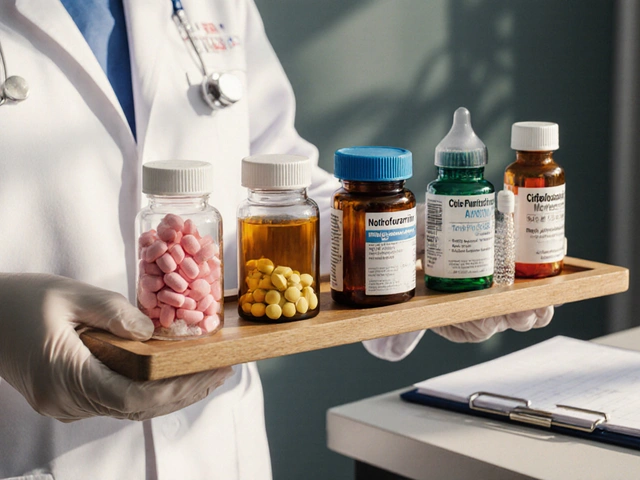Diabetes Medication Selector
Glucovance is a fixed‑dose combination of metformin and glibenclamide approved for type2 diabetes management. It pairs a biguanide (metformin) with a sulfonylurea (glibenclamide) to deliver dual action: reduced hepatic glucose production and stimulated insulin release. Launched in the late‑1990s, Glucovance remains a cost‑effective option, especially where newer agents are not reimbursed.
Why Patients and Clinicians Still Reach for Glucovance
Glucovance’s appeal comes from three core attributes:
- Broad HbA1c impact - Clinical trials show average reductions of 1.5-2.0% when baseline HbA1c is around 9%.
- Low acquisition cost - Generic metformin and glibenclamide keep the monthly price well under £15 in the UK.
- Simple dosing - Once‑daily tablets fit easily into routine, reducing missed doses.
However, the same mechanisms that drive glucose control also generate side‑effects. The sulfonylurea component can cause hypoglycaemia, especially in elderly patients or those with renal impairment. Metformin, while generally safe, may provoke gastrointestinal upset and carries a rare risk of lactic acidosis.
Key Alternatives in the Oral Diabetes Landscape
Over the past decade, several newer drug classes have entered the market. They differ in how they control blood sugar, side‑effect profile, and extra‑cardiovascular benefits. Below are the most common alternatives that clinicians compare with Glucovance.
Metformin is a biguanide that improves insulin sensitivity and lowers hepatic glucose output. It is the first‑line therapy for type2 diabetes worldwide. Glibenclamide (also known as glyburide) is a second‑generation sulfonylurea that triggers pancreatic β‑cell insulin release. Janumet is a fixed‑dose combo of metformin and sitagliptin, a DPP‑4 inhibitor that works by increasing incretin levels. Sitagliptin is a DPP‑4 inhibitor that prolongs the action of GLP‑1 and GIP hormones, enhancing glucose‑dependent insulin secretion. Empagliflozin is an SGLT2 inhibitor that blocks renal glucose reabsorption, promoting urinary glucose excretion.Side‑Effect Profiles: What to Watch For
Understanding safety is crucial when swapping drugs. The table below condenses the most relevant adverse‑event data for each option.
| Drug | Primary Mechanism | Typical HbA1c Reduction | Hypoglycaemia Risk | Weight Impact | Cardiovascular Benefit | Average Monthly Cost (UK) |
|---|---|---|---|---|---|---|
| Glucovance | Biguanide + Sulfonylurea | 1.5-2.0% | Moderate (↑ with renal decline) | Neutral‑to‑slight loss | No proven benefit | ≈£12 |
| Metformin | Biguanide | 1.0-1.5% | Low | Weight loss (~1‑2kg) | Modest reduction in CV events | ≈£5 |
| Glibenclamide | Sulfonylurea | 1.2-1.6% | High (especially in elderly) | Weight gain (+1‑2kg) | No CV benefit | ≈£4 |
| Janumet | Biguanide + DPP‑4 inhibitor | 1.5-1.8% | Low‑moderate | Neutral | Neutral | ≈£25 |
| Empagliflozin | SGLT2 inhibitor | 0.5-1.0% | Very low | Weight loss (2‑3kg) | Significant CV & renal protection | ≈£70 |
When to Stick With Glucovance
Glucovance shines in three typical scenarios:
- Patients with limited insurance coverage - The low price makes it accessible for NHS formulary budgeting.
- Those needing rapid HbA1c drop - The sulfonylurea component pushes insulin release, delivering a quick reduction when baseline glucose is high.
- Individuals already stable on metformin - Adding glibenclamide in a single tablet avoids the pill burden of separate prescriptions.
Yet, clinicians must screen for renal function (eGFR<30mL/min/1.73m²) and age‑related hypoglycemia risk before persisting with the combo.

Choosing an Alternative: Decision Framework
Switching from Glucovance isn’t a one‑size‑fits‑all move. Use the following checklist to match patient characteristics with drug profiles.
- Renal impairment - Prefer SGLT2 inhibitors (e.g., empagliflozin) or DPP‑4 inhibitors; avoid sulfonylureas.
- Weight concerns - Metformin, SGLT2 inhibitors, and GLP‑1‑based combos promote loss; sulfonylureas tend to add weight.
- Cardiovascular disease - Empagliflozin and some GLP‑1 agents have proven CV benefit.
- Cost sensitivity - Metformin alone or generic sulfonylureas remain cheapest; newer agents cost more.
- Hypoglycemia aversion - DPP‑4 and SGLT2 inhibitors carry the lowest risk.
Real‑World Example: Switching a 68‑Year‑Old with CKD
Mrs. Ahmed, 68, has a baseline HbA1c of 8.9% on Glucovance. Recent labs show eGFR 45mL/min/1.73m² and she reported a mild hypoglycemic episode. Using the checklist, her clinician decided to replace the sulfonylurea with a DPP‑4 inhibitor, creating a Janumet regimen. After three months, her HbA1c fell to 7.6% without further lows, and her eGFR remained stable. The modest cost increase was covered by her private prescription plan.
Future Outlook: Where Fixed‑Dose Combinations Are Heading
Pharmaceutical innovators are now pairing metformin with agents that not only lower glucose but also protect the heart and kidneys. In 2025, the FDA approved a metformin‑empagliflozin combo, aiming to bring the benefits of SGLT2 inhibition to the cheap, familiar metformin backbone. If pricing aligns with NHS standards, such combos could eventually eclipse traditional sulfonylurea pairings like Glucovance.
Key Take‑aways
- Glucovance offers strong glucose‑lowering power at a low price but carries hypoglycemia and weight‑gain risks.
- Modern alternatives (DPP‑4, SGLT2 inhibitors, GLP‑1 combos) provide safer profiles and added cardio‑renal benefits, at higher cost.
- Patient‑specific factors-renal function, weight goals, cardiovascular history, and budget-should drive the selection.
- Future fixed‑dose combos may blend metformin with newer agents, potentially reshaping the cost‑benefit landscape.
Frequently Asked Questions
What is the main advantage of Glucovance over metformin alone?
Glucovance adds glibenclamide, a sulfonylurea, to metformin. The sulfonylurea stimulates insulin release, so the combo typically drops HbA1c 0.5‑1% more than metformin monotherapy, especially when baseline glucose is high.
Can I switch from Glucovance to a newer drug without losing control?
Yes, if you choose an alternative that matches your clinical profile. For example, a metformin‑sitagliptin combo (Janumet) often maintains similar HbA1c reductions while reducing hypoglycemia risk. Always do the switch under medical supervision.
Is glibenclamide safe for people with kidney problems?
Glibenclamide is cleared by the kidneys, so in chronic kidney disease (eGFR<30mL/min) the risk of hypoglycemia rises sharply. Guidelines recommend dose reduction or switching to a drug with hepatic clearance, such as a DPP‑4 inhibitor.
How does the cost of Glucovance compare with empagliflozin?
Glucovance costs roughly £12 per month as a generic combo in the UK, while empagliflozin (a branded SGLT2 inhibitor) runs about £70 per month. The price gap is significant, but empagliflozin adds proven cardiovascular and renal protection, which may offset costs in high‑risk patients.
What should I monitor after changing from Glucovance to another therapy?
Track fasting glucose and HbA1c every 3months, watch for signs of hypoglycemia (especially if sulfonylureas are still present), and re‑check renal function and weight. If you start an SGLT2 inhibitor, also monitor for urinary tract infections.








One might assume the mere presence of a sulfonylurea–metformin combo automatically renders it obsolete, but the data tells a subtler tale.
When renal function dips below 60 mL/min, the risk of hypoglycemia with Glucovance spikes, urging clinicians to consider newer SGLT2 inhibitors.
Conversely, for patients with a baseline HbA1c around 7 %, a modest dose adjustment can keep glucose in check without the costly side‑effects of the latest agents.
Thus the decision matrix remains a balancing act between efficacy, safety, and pharmacy budgets.
In short, don’t discard the old guard merely because it’s vintage.
When you stare at a menu of diabetes drugs you’re really looking at a philosophy of risk and reward, a sort of modern alchemy where numbers replace gold.
Glucovance sits at the crossroads of simplicity and legacy, a relic that still whispers “I’ve been here since the 80s” while the newer agents shout “I’ve got cardio‑protective flair.”
You can’t ignore the fact that older drugs have a massive evidence base, a safety record that reads like a novel rather than a footnote.
Yet the bright new GLP‑1 agonists bring weight loss benefits that the old duo simply cannot match.
The real question, however, is whose life are we trying to improve – the one measured by HbA1c alone, or the whole person juggling comorbidities, wallets, and lifestyle?
Take a 72‑year‑old with an eGFR of 55 mL/min; stacking metformin on top of a sulfonylurea could invite dangerous hypoglycemia, while an SGLT2 inhibitor might preserve kidney function.
On the other hand, a 45‑year‑old with a baseline of 8.5 % may find the predictable dosing of Glucovance a comfort amidst a chaotic world.
Economics also play a starring role – insurance formularies still favor the cheap combos, which means many patients never even see the newer options on the shelf.
From a mechanistic perspective, the combination blocks hepatic glucose output and enhances peripheral uptake, a double‑hit that’s hard to replicate with a single molecule.
Meanwhile the “modern” drugs often attack the gut or the kidneys, offering different pathways that might synergize but also complicate titration.
If you factor in adherence, a twice‑daily pill can be less attractive than a once‑weekly injection for some, yet the needle phobia crowd will argue the opposite.
Clinical guidelines now recommend individualization, a word that sounds polite but actually hides a lot of gray area.
In practice, clinicians often run a cost‑benefit analysis on a spreadsheet, weighing A1c reduction against side‑effects and pill burden.
The bottom line is that there is no one‑size‑fits‑all, and the best choice is the one that aligns with the patient’s values, comorbid profile, and financial reality.
So, whichever path you walk, remember that vigilant monitoring is the compass that keeps you from getting lost.
Glucovance is like that old sitcom you keep rewatching because it’s familiar but it’s missing the sparkle of the new hits you hear about on podcasts it’s safe I guess but also boring and the side effects are like a drama that never ends new drugs are the blockbuster series with twists and better graphics but they cost a fortune and sometimes the hype outpaces the science so you’re stuck watching reruns or paying for the premiere
Hey folks, let’s shine a light on why Glucovance can still be a hero for many!
When the kidneys are still humming along, the combo gives a steady, predictable drop in sugar without the flash‑in‑the‑pan hype.
It’s also a wallet‑friendly option that lets patients stay on track without draining their accounts.
But don’t ignore the spark of newer agents – they can add cardio‑protective firepower when the situation calls for it.
Bottom line: match the drug to the person, not just the label, and you’ll find the sweet spot.
Glucovance works fine if you keep an eye on kidney numbers.
Stick to the dose guide and you’ll avoid most lows.
Ask your doc about alternative if eGFR drops below 60.
Simple as that.
Glucovance just isn’t cutting it anymore.
While many hail the “new kid on the block” as a panacea, it’s worth remembering that older therapies like Glucovance have survived decades of scrutiny, which is no small feat.
Sure, the marketing barrage pushes GLP‑1 agonists as the ultimate solution, but the side‑effect profile-nausea, vomiting, and sometimes pancreatitis-can be a dealbreaker.
Moreover, the cost differential is staggering; a patient on a generic sulfonylurea‑metformin combo might spend a fraction of what a premium weekly injection demands.
Clinical outcomes, however, aren’t solely about numbers; they’re about quality of life, and for many, the simplicity of a twice‑daily pill outweighs the allure of cutting‑edge pharmacology.
That said, if you’re a lover of the latest trends, you might argue that the cardiovascular benefits documented in recent RCTs are enough to supersede all concerns.
But let’s not forget that adherence suffers when regimens become overly complex, and the real‑world effectiveness can plummet.
In essence, the “best” drug is context‑dependent, and dismissing the tried‑and‑true as obsolete would be a myopic view.
Look, the pharma lobby slaps the new GLP‑1s on the market like it’s a patriotic crusade, but the reality is they’re just pricey gimmicks designed to bleed American wallets.
The mechanistic jargon-“dual GIP/GLP‑1 agonism” and “biased signaling”-sounds impressive, yet it masks the fact that the clinical advantage over a solid sulfonylurea‑metformin combo is marginal for the average patient.
Moreover, the adverse event profile-ranging from GI upset to rare but serious diabetic ketoacidosis-doesn’t justify the inflation of drug costs.
If you’re serious about evidence‑based practice, you’ll see that the cost‑effectiveness ratio of Glucovance still outperforms most of these overhyped entrants.
Bottom line: don’t let the hype train dictate therapy when the tried‑and‑true still delivers.
Let’s get moving on your diabetes plan! Glucovance can be a solid baseline if your kidneys are in good shape. Pair it with diet and exercise and you’ll see steady progress. Upgrade to newer agents only when you need that extra boost. Keep tracking your numbers and stay motivated!
Coach’s tip: start with Glucovance if eGFR is ≥60, monitor A1c monthly, and adjust dose before jumping to pricey alternatives. If you notice hypoglycemia, switch to a DPP‑4 inhibitor-cost-effective and low risk. Consistency beats flash any day.
Let’s be clear: the literature is littered with half‑cooked studies that glorify the newest meds while ignoring the robust data behind Glucovance.
It’s a common mistake to dismiss older therapies because they lack “buzz‑words.”
When you read the methodology sections, you’ll see that many trials on SGLT2 inhibitors have small sample sizes and short follow‑ups.
In contrast, the sulfonylurea‑metformin combo has been evaluated in thousands of patients over decades.
So, before you jump on the hype bandwagon, check the source credibility and statistical power.
In reviewing the comparative efficacy of Glucovance versus contemporary agents, one must consider both pharmacokinetic profiles and health‑economic implications.
The sulfonylurea component possesses a well‑characterized hepatic metabolism, whereas newer agents often rely on renal excretion pathways that may be compromised in older populations.
Furthermore, the price differential remains a salient factor in formulary decisions, as insurance coverage frequently favors the generic combination.
Consequently, a thorough patient‑centered assessment remains indispensable.
Okay, I’ve heard the whispers that Big Pharma is secretly pushing newer meds to keep us all hooked on their endless cycles of “innovation.”
While that sounds like a plot straight out of a thriller, the fact is that Glucovance still holds its ground for many patients who can’t afford the premium price tags.
Don’t let the marketing hype blind you – keep an eye on your A1c, listen to your body, and don’t be afraid to question the narrative.
Stay safe out there, friends.
It is essential, dear readers, to recognize the ethical dimensions of prescribing practices; the allure of novel therapies must not eclipse the principle of “primum non nocere.”
When a tried‑and‑true regimen such as Glucovance can adequately control glycemia, the moral imperative is to avoid unnecessary escalation to more expensive, and potentially riskier, agents.
Thus, clinicians should exercise prudence, weigh cost‑benefit ratios, and engage patients in shared decision‑making.
While many champion the latest drugs as the holy grail of diabetes care, I tend to stay skeptical of the fervor surrounding them; after all, incremental A1c drops may not translate into meaningful clinical outcomes for every individual.
Glucovance works fine for some but if your kidneys are low it’s not the best.
New drugs have stuff that can help more, but they’re pricey.
Just talk to your doc.
It would be a misapprehension to assert that contemporary agents categorically supersede the efficacy of Glucovance; the evidence base supporting the latter remains robust, particularly in patient subsets with preserved renal function.
Philosophically speaking, the choice between an antiquated sulfonylurea‑metformin combo and a state‑of‑the‑art GLP‑1 agonist mirrors the age‑old debate of tradition versus innovation.
One must not dismiss the proven track record of Glucovance merely because it lacks the sheen of novelty.
Conversely, the cardioprotective attributes of newer agents merit serious consideration.
The crux lies in aligning pharmacologic potency with patient‑centric values.
When cost barriers impede access, the “best” drug becomes the one that is actually obtainable.
Thus, a balanced, evidence‑based approach, free from marketing bias, is paramount.
Remember, the ultimate goal is sustainable glycemic control, not the pursuit of the latest headline.
Stay informed and stay healthy.
In the grand theater of diabetes management, each medication plays a distinct character, each with its own entrance, climax, and denouement.
Glucovance, the veteran protagonist, has weathered decades of clinical scrutiny, earning applause for its reliability and affordability.
Yet the supporting actors-SGLT2 inhibitors, GLP‑1 receptor agonists, and the latest DPP‑4 inhibitors-have entered the stage with fanfare, promising not just glycemic control but also cardioprotective and renoprotective subplots.
The audience, that is, the patient, often finds themselves torn between the comforting familiarity of the seasoned lead and the dazzling allure of the newcomers.
One must consider the script of renal function, for an eGFR below 60 casts a long shadow over sulfonylurea safety, potentially leading to hypoglycemic drama that no one enjoys.
On the other hand, the new agents bring their own complexities: weekly injections, gastrointestinal side‑effects, and, of course, the ever‑looming specter of cost.
When the storyboard includes cardiovascular disease, the newer cast members often receive a standing ovation due to robust trial data supporting reduced events.
However, if the plot revolves around simple glucose‑lowering without comorbidities, Glucovance can still deliver a satisfying performance.
Financial considerations, too, influence casting decisions; insurers frequently favor the generic duo, granting them more stage time.
Thus, the director-your endocrinologist-must balance artistic vision with budgetary constraints, ensuring the final production is both safe and impactful.
In the end, the most compelling narrative is one co‑written by patient preferences, clinical evidence, and realistic resource allocation.
Finding the right diabetes med is all about personal fit.